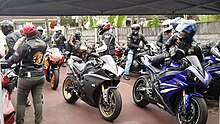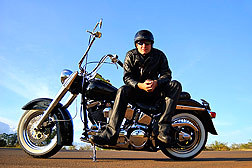Motorcycle
Background
The motorcycle is "a form of
entertainment that can appeal only, one would think, to the most
enthusiastic of mechanical eccentrics,"
Engineering magazine
stated in 1901. "We think it doubtful whether the motorcycle will, when
the novelty has worn off, take a firm hold of public favour."
Last
year, four million motorcycles were in use in the United States alone.
Whether relied upon as a primary means of transportation, used to
provide weekend recreation, souped up and sped along for racing, or
displayed as antique, millions of people across the world have shown
that the novelty most definitely has not worn off.
History
As
might be imagined, the motorcycle evolved from a vehicle powered by
sheer human energy—the bicycle. French bicycle maker Pierre Michaux and
his sons Ernest and Henri first fitted a bicycle with cranks and
pedals—precursors to the modern-day motor—in 1861. The Michauxes'
velocipede was an instant hit and the family became the largest velo
producer in Europe with a large factory at Bar-le-Duc in France. Working
with Michaux, L.G. Perreaux devised a steam-powered motorcycle engine,
called a
velo-a-vapeur, which was patented in 1868. Sylvester
Howard Roper of Roxbury, Massachusetts pioneered a similar invention in
the United States around that time as well.
In 1879, Giuseppe
Munigotti of Italy patented the first gas-burning internal combustion
four-stroke engine for the new motorcycles, although his invention
existed only on paper. Meanwhile, two Germans, Dr. Nicolaus Otto and
Eugen Langen were developing four-stroke stationary engines, which ran
on coal gas supplied from mains. Gottlieb Daimler took the invention
further by developing an engine that ran on benzine. Since benzine could
carry a vehicle approximately 25 miles on one gallon, only a small tank
would need to be attached to the machine. Daimler later abandoned the
motorcycle business to concentrate on another invention—the first
automobile that became the basis for his company, Daimler Benz, maker of
the luxury Mercedes Benz automobile.
Several innovators improved
upon these inventions over the next 30 years, and in 1901 the machine
that is still regarded as Carl Hedstrom, a Swedish immigrant to the
United States, developed the first modern motorcycle. Hedstrom fitted an
Indian bicycle with a 1.75-horsepower single-cylinder engine, and the
legendary Indian motorcycle was born. Several other U.S. makers came out
with similar models, including the company whose name is synonymous
with the motorcycle—Harley-Davidson—in 1903. William Harley and Arthur
Davidson were students in Milwaukee when they built their first
motorcycle on a borrowed lathe from patterns they had made. Davidson's
older brothers, both toolmakers, assisted, as did Ole Evinrude, who
later became famous as a designer and producer of outboard motor boat
engines.
Other makers included Royal, Merkel, Yale,
Reading-Standard, Rambler, Tribune and Curtiss. By 1904, motorcycle
manufacturers had begun to construct bulkier, sturdier frames, stronger
wheels, bigger engines and
reinforced forks for their bikes and a clear distinction between
motorcycles and bicycles emerged. Around this time, the sidecar, affixed
to a light, tubular frame extending from the main motorcycle frame,
began to be popularized. Based on a similar accessory for the bicycle,
his device allowed the driver of a motorcycle to carry a passenger.
By
1905, the focus was on power, and manufacturers begin to beef up their
engines. That year, Hedstrom produced a machine boasting a 500 cc twin
engine that featured twist-grip control for the throttle and ignition.
That same year saw the development of "free engine" devices, which eased
the starting and launching of a machine, and variable gears, which
eased use on hills and at slow speeds. Chain drive followed, and the
stage was set for production of the motorcycle that is currently in use.
Motorcycles
continued to grow in popularity for decades, although production for
civilians tapered off during World War II. During World War II, however,
a need arose for lightweight, collapsible models to be used by
parachutists once they had landed. Royal Enfield produced a Flying Flea
model for this purpose, while Excelsior came up with its Welbike, which
could fit into a small air-drop container. The Welbike was later
marketed to civilians as the Corgi, spawning the post-war popularity of
the motor scooter, especially in Europe.
The 1950s were regarded
as a "golden age" for the motorcycle, with its use being popularized by
such prominent figures in popular culture as James Dean in his movie
"Rebel Without a Cause." The United States and Europe dominated the
motorcycle industry through 1960, at which time Japanese manufacturers,
including Honda, Yamaha, Suzuki and Kawasaki, rose to a prominence they
maintain to this day.
The Europeans took the lead in developing
the motorcycle in the early twentieth century. One Englishman proclaimed
his countrymen loved the cycle because they enjoyed mechanical things.
However, Americans enjoyed their motorcycles as well. An American
gentleman could have purchased this home-grown motorcycle manufactured
in 1911 by the Hendee Manufacturing Co. of Springfield, Massachusetts.
Hendee made early American motorcycles, which featured Native American
names indicating a proud ruggedness. Red with gold striping, this one
cylinder 3.5 horesepower loop-framed cycle weighs 140 lb (63.6 kg), has a
wheel diameter of 23.5 in (59.7 cm) and cost a whopping $225.00 back in
1911. Founded in 1901, the company ceased operation in 1953. However,
Indian motorcycles are still beloved—enthusiasts claim that there are
still 50,000 Indian motorcycles on the road.
Indian bikes might
reach 60 m.p.h., but handbooks cautioned riders to not exceed 10 m.p.h.
through town. These early handbooks are full of advice and etiquette for
the motorcyclist. Some period gems include: don't ride with the muffler
open as "the noise scares restive horses, and worries invalids and
nervous people," don't run away in case of accident but "stand by like a
man … don't get rattled," and don't ride by a motorcyclist who is
stalled by the side of the rode as "you may be in the same fix yourself
some day."
Nancy EV Bryk
Raw Materials
The
primary raw materials used in the manufacture of the body of motorcycle
are metal, plastic and rubber. The motorcycle frame is composed almost
completely of metal, as are the wheels. The frame may be overlaid with
plastic. The tires are composed of rubber. The seat is made from a
synthetic substance, such as polyurethane. The power system consists of a
four-stroke engine, a carburetor to transform incoming fuel into vapor,
a choke to control the air-fuel ratio, transmission, and drum brakes.
The transmission system contains a clutch, consisting of steel ball
flyweights and metal plates, a crankshaft, gears, pulleys, rubber belts
or metal chains, and a sprocket. The
electrical system contains a battery, ignition wires and coils, diodes,
spark plugs, head-lamps and taillights, turn signals and a horn.
A
cylindrical piston, made of aluminum alloy (preferred because it is
lightweight and conducts heat well), is an essential component of the
engine. It is fitted with piston rings made of cast iron. The crankshaft
and crankcase are made of aluminum. The engine also contains a cylinder
barrel, typically made of cast iron or light alloy.
The Manufacturing
Process
- Raw
materials as well as parts and components arrive at the manufacturing
plant by truck or rail, typically on a daily basis. As part of the
just-in-time delivery system on which many plants are scheduled, the
materials and parts are delivered at the place where they are used or
installed.
- Manufacturing begins in the weld department with
computer-controlled fabrication of the frame from high strength frame
materials. Components are formed out of tubular metal and/or hollow
metal shells fashioned from sheet metal. The various sections are welded
together. This process involves manual, automatic, and robotic
equipment.
- In the plastics department, small plastic resin
pellets are melted and injected into molds under high pressure to form
various plastic body trim parts. This process is known as injection
molding.
- Plastic and metal parts and components are painted in
booths in the paint department using a process known as powder-coating
(this is the same process by which automobiles are painted). A
powder-coating apparatus works like a large spray-painter, dispersing
paint through a pressurized system evenly across the metal frame.
- Painted
parts are sent via overhead conveyors or tow motor (similar to a ski
lift tow rope) to the assembly department where they are installed on
the frame of the motorcycle.
- The engine is mounted in the painted frame, and various other
components are fitted as the motorcycle is sent down the assembly line.
- Wheels,
brakes, wiring cables, foot pegs, exhaust pipes, seats, saddlebags,
lights, radios, and hundreds of other parts are installed on the
motorcycle frame. A Honda Gold Wing motorcycle, for example, needs
almost as many parts to complete it as a Honda Civic automobile.
Quality Control
At
the end of the assembly line, quality control inspectors undertake a
visual inspection of the motorcycle's painted finish and fit of parts.
The quality control inspectors also feel the motorcycles with gloved
hands to detect any bumps or defects in the finish. Each motorcycle is
tested on a dynamometer. Inspectors accelerate the motorcycle from 0-60
mph. During the acceleration, the "dyno" tests for acceleration and
braking, shifting, wheel alignment, headlight and taillight alignment
and function, horn function, and exhaust emissions. The finished product
must meet international standards for performance and safety. After the
dyno test, a final inspection is made of the completed motorcycle. The
motorcycles are boxed in crates and shipped to customers across North
America and around the world.
The Future
Motorcycles
remain popular and the collecting and riding of antique models is just
as popular as riding the new versions. While sleek, new versions will
continue to be produces,
it is anticipated that the value of older models will continue to rise.
Where to Learn More
Books
Ayton, Cyril, Bob Holliday, Cyril Posthumus and Mike Winfield.
The History of Motorcycling. London: Orbis Publishing, 1979.
Lear, George and Lynn S. Mosher,
Motorcycle Mechanics. Englewood Cliffs, NJ: Prentice Hall, 1997.
—
Kristin Palm



